CD8+ T cell activation in cancer comprises an initial activation phase in lymph nodes followed by effector differentiation within the tumor
- PMID: 36580918
- PMCID: PMC10266440
- DOI: 10.1016/j.immuni.2022.12.002
CD8+ T cell activation in cancer comprises an initial activation phase in lymph nodes followed by effector differentiation within the tumor
Abstract
Improvements in tumor immunotherapies depend on better understanding of the anti-tumor T cell response. By studying human tumor-draining lymph nodes (TDLNs), we found that activated CD8+ T cells in TDLNs shared functional, transcriptional, and epigenetic traits with TCF1+ stem-like cells in the tumor. The phenotype and TCR overlap suggested that these TDLN cells were precursors to tumor-resident stem-like CD8+ T cells. Murine tumor models revealed that tumor-specific CD8+ T cells were activated in TDLNs but lacked an effector phenotype. These stem-like cells migrated into the tumor, where additional co-stimulation from antigen-presenting cells drove effector differentiation. This model of CD8+ T cell activation in response to cancer is different from that of canonical CD8+ T cell activation to acute viruses, and it proposes two stages of tumor-specific CD8+ T cell activation: initial activation in TDLNs and subsequent effector program acquisition within the tumor after additional co-stimulation.
Keywords: CD8 T cells; T cell differentiation; T cell exhaustion; antigen-presenting cells; cancer; co-stimulation; tumor-draining lymph nodes; tumor-infiltrating lymphocytes.
Copyright © 2022 Elsevier Inc. All rights reserved.
Conflict of interest statement
Declaration of interests The authors declare no competing interests.
Figures
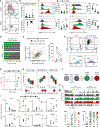
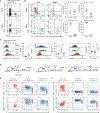

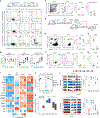

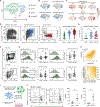
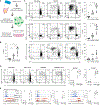
Similar articles
-
Lymphocytes in tumor-draining lymph nodes co-cultured with autologous tumor cells for adoptive cell therapy.J Transl Med. 2022 May 23;20(1):241. doi: 10.1186/s12967-022-03444-1. J Transl Med. 2022. PMID: 35606862 Free PMC article.
-
CD8+CXCR5+ T cells in tumor-draining lymph nodes are highly activated and predict better prognosis in colorectal cancer.Hum Immunol. 2018 Jun;79(6):446-452. doi: 10.1016/j.humimm.2018.03.003. Epub 2018 Mar 12. Hum Immunol. 2018. PMID: 29544815
-
PGE2 limits effector expansion of tumour-infiltrating stem-like CD8+ T cells.Nature. 2024 May;629(8011):417-425. doi: 10.1038/s41586-024-07254-x. Epub 2024 Apr 24. Nature. 2024. PMID: 38658748 Free PMC article.
-
Tumor draining lymph nodes, immune response, and radiotherapy: Towards a revisal of therapeutic principles.Biochim Biophys Acta Rev Cancer. 2022 May;1877(3):188704. doi: 10.1016/j.bbcan.2022.188704. Epub 2022 Feb 25. Biochim Biophys Acta Rev Cancer. 2022. PMID: 35227831 Review.
-
Antigen-nonspecific activation of CD8+ T lymphocytes by cytokines: relevance to immunity, autoimmunity, and cancer.Arch Immunol Ther Exp (Warsz). 2008 Sep-Oct;56(5):311-23. doi: 10.1007/s00005-008-0033-2. Arch Immunol Ther Exp (Warsz). 2008. PMID: 18836862 Review.
Cited by
-
LRP11 promotes stem-like T cells via MAPK13-mediated TCF1 phosphorylation, enhancing anti-PD1 immunotherapy.J Immunother Cancer. 2024 Jan 25;12(1):e008367. doi: 10.1136/jitc-2023-008367. J Immunother Cancer. 2024. PMID: 38272565 Free PMC article.
-
Challenges in developing personalized neoantigen cancer vaccines.Nat Rev Immunol. 2024 Mar;24(3):213-227. doi: 10.1038/s41577-023-00937-y. Epub 2023 Oct 2. Nat Rev Immunol. 2024. PMID: 37783860 Review.
-
Immune characteristics associated with lymph node metastasis in early-stage NSCLC.Cell Oncol (Dordr). 2024 Apr;47(2):447-461. doi: 10.1007/s13402-023-00873-y. Epub 2023 Sep 20. Cell Oncol (Dordr). 2024. PMID: 37728859
-
Bladder cancer intrinsic LRFN2 drives anticancer immunotherapy resistance by attenuating CD8+ T cell infiltration and functional transition.J Immunother Cancer. 2023 Oct;11(10):e007230. doi: 10.1136/jitc-2023-007230. J Immunother Cancer. 2023. PMID: 37802603 Free PMC article.
-
The diverse effects of transforming growth factor-β and SMAD signaling pathways during the CTL response.Front Immunol. 2023 Jun 23;14:1199671. doi: 10.3389/fimmu.2023.1199671. eCollection 2023. Front Immunol. 2023. PMID: 37426662 Free PMC article. Review.
References
-
- Azimi F, Scolyer RA, Rumcheva P, Moncrieff M, Murali R, McCarthy SW, Saw RP, and Thompson JF (2012). Tumor-infiltrating lymphocyte grade is an independent predictor of sentinel lymph node status and survival in patients with cutaneous melanoma. J. Clin. Oncol. 30, 2678–2683. 10.1200/JCO.2011.37.8539. - DOI - PubMed
Publication types
MeSH terms
Grants and funding
LinkOut - more resources
Full Text Sources
Other Literature Sources
Research Materials

